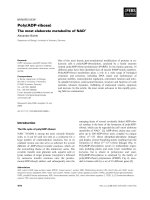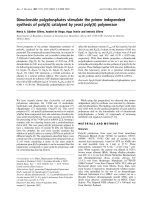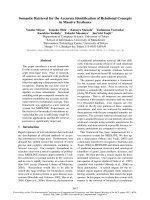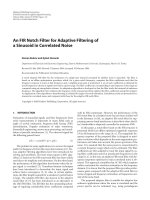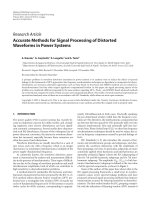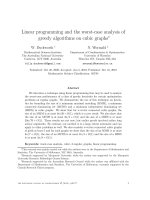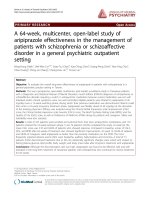Báo cáo y học: " Hypertension may be the most important component of hyperdynamic therapy in cerebral vasospasm" pot
Bạn đang xem bản rút gọn của tài liệu. Xem và tải ngay bản đầy đủ của tài liệu tại đây (117.93 KB, 2 trang )
In a previous issue of Critical Care, Dankbaar and
colleagues [1] presented a systematic review of clinical
studies of hyperdynamic therapy and its components on
cerebral blood fl ow (CBF). Symptomatic cerebral
vasospasm is defi ned as cerebral ischemia attributable to
narrowing of intracranial arteries and loss of cerebral
autoregulation, and affl icts some 20 to 25% of patients
after rupture of an intracranial aneurysm [2,3]. e
corner stone of medical therapy for cerebral vasospasm is
so-called hyperdynamic therapy. Also referred to as
triple-H therapy, this strategy includes the use of hyper-
tension, hypervolemia, and hemodilution to optimize
cerebral perfusion. Introduced in the 1970s, this manage-
ment strategy has become widely accepted as fi rst-line
treatment for symptomatic vasospasm and is probably
used in one form or another in nearly all neurosurgical
centers. Indeed, this author favors the use of induced
hypertension and volume supplementation for primary
treatment of symptomatic vasospasm, prior to endo-
vascular treatment, and, anecdotally, has observed rapid
neurological improvement - over the course of an hour or
less - in such circumstances. is acceptance of hyper-
dynamic therapy has evolved despite a relatively modest
amount of supportive clinical evidence. e recent
American Heart Association Guidelines for the Manage-
ment of Aneurysmal Subarachnoid Hemorrhage described
hyperdynamic therapy only as ‘one reasonable approach’
for the treatment of symptomatic vasospasm (Class IIa
treatment eff ect, level of evidence B) [4]. Hyperdynamic
therapy, particularly hypervolemic therapy, also comes
with a price in terms of complications (reported in up to
30% of cases [5,6]) and cost. Furthermore, it is not yet
clear which components of hyperdynamic therapy are
most important.
Dankbaar and colleagues [1] provide a systematic
review of clinical studies of hyperdynamic therapy and its
components on CBF. Why focus on CBF instead of
neurological or overall clinical outcomes? An increase in
cerebral perfusion is the mechanism by which hyper-
dynamic therapy is purported to exert its benefi cial
eff ect, and increases in CBF have been linked to clinical
improvement in patients with symptomatic vasospasm
[7]. Also, an assortment of quantitative CBF measure-
ment techniques have appeared in the past two decades,
permitting relatively precise and quantitative analyses of
the eff ects of hyperdynamic therapy.
Dankbaar and coworkers found 11 studies; only one
included a control group and the remaining studies
compared CBF before and during treatment. Hypertension
was associated with an increase in CBF in two of four
studies examining hypertension alone, and one of two
studies assessing triple-H therapy found an increase in
CBF. Only one of seven studies of hypervolemia found a
signifi cant increase in CBF compared to baseline. Hemo-
dilution did not change CBF. A meta-analysis of the
Abstract
Although hyperdynamic therapy is an accepted
method of treatment of patients with symptomatic
cerebral vasospasm after aneurysmal subarachnoid
hemorrhage, it remains unproven in large scale trials
and controlled studies. Furthermore, methods of
hyperdynamic therapy and speci c endpoints vary
widely. A systematic review of clinical trials of the
various techniques of hyperdynamic therapy and
their e ects on cerebral blood ow found only 11
studies suitable for analysis. Although controlled trials
are lacking, there is some evidence to suggest that
hypertension is the most promising component of
hyperdynamic therapy. These ndings support a future
randomized trial of induced hypertension in patients
with symptomatic cerebral vasospasm.
© 2010 BioMed Central Ltd
Hypertension may be the most important
component of hyperdynamic therapy in cerebral
vasospasm
Mark R Harrigan*
See related research by Dankbaar et al., />COMMENTARY
*Correspondence:
Department of Surgery, Division of Neurosurgery, University of Alabama at
Birmingham, 510 20th Street South, Birmingham, AL 35294, USA
Harrigan Critical Care 2010, 14:151
/>© 2010 BioMed Central Ltd
results was not possible due to study heterogeneity.
Complication rates were also diffi cult to assess because
they were included in only fi ve of the studies, although it
is interesting that complication rates of zero were
reported in two trials that included hypertension.
e fi ndings of this study are not surprising, as induced
hypertension makes the most sense on a theoretical and
practical basis. A key feature of cerebral vasospasm is loss
of autoregulation [8,9], resulting in passive dependence
of cerebral perfusion on systemic blood pressure. When
loss of autoregulation is combined with a reduction in
capacitance vessel caliber, cerebral perfusion becomes
even more dependent on systemic blood pressure. It
seems logical then that raising blood pressure is the most
direct way to enhance CBF.
In contrast, hypervolemia is problematic because fl uid
balance is a poor surrogate for circulating blood volume
[10] and sustained volume expansion is diffi cult to
maintain [11]. Hypervolemia also appears to be the
compo nent of hyperdynamic therapy most associated
with complications, such as pulmonary edema, conges-
tive heart failure, and cerebral edema [11,12]. Since
hypovolemia can also be hazardous in this setting, by
exacerbating cerebral ischemia [11], maintenance of a
normovolemic state may be the most prudent strategy.
Hemodilution is even more problematic because the
optimal hematocrit in patients with cerebral vasospasm
is not known, and hemodilution has been associated with
worsening of cerebral ischemia in clinical practice [13].
In addition to suggesting that hypertension may be the
most eff ective component of hyperdynamic therapy, this
review also hints that hypertension may actually be the
safest component of hyperdynamic therapy. Much remains
to be discovered, however. A wide array of diff erent
options for hypertensive therapy exists; the clinician
must choose a vasopressor (dobutamine, phenylephrine
or dopamine), a method of assessment (systolic blood
pressure, cerebral perfusion pressure, or pulmonary
capillary wedge pressure), and a therapeutic goal. No
technique of hypertensive therapy has yet been shown to
be superior to others. is is fertile ground for a well
controlled, randomized trial. Based on their analysis,
Dankbaar and coworkers managed to estimate that only a
total of 104 subjects would be necessary for a two-armed
trial of hypertensive therapy in patients with symptomatic
cerebral vasospasm. Such a trial would be feasible and
quick to complete.
Abbreviations
CBF = cerebral blood ow.
Competing interests
The author declares that he has no competing interests.
Published: 14 May 2010
References
1. Dankbaar JW, Slooter AJC, Rinkel GJ, van der Schaaf IC: E ect of di erent
components of triple-H therapy on cerebral perfusion in patients with
aneurysmal subarachnoid haemorrhage: a systematic review. Crit Care
2010, 14:R23.
2. Murayama Y, Malisch T, Guglielmi G, Mawad ME, Vinuela F, Duckwiler GR,
Gobin YP, Klucznick RP, Martin NA, Frazee J: Incidence of cerebral vasospasm
after endovascular treatment of acutely ruptured aneurysms: report on 69
cases. J Neurosurg 1997, 87:830-835.
3. Charpentier C, Audibert G, Guillemin F, Civit T, Ducrocq X, Bracard S, Hepner
H, Picard L, Laxenaire MC: Multivariate analysis of predictors of cerebral
vasospasm occurrence after aneurysmal subarachnoid hemorrhage. Stroke
1999, 30:1402-1408.
4. Bederson JB, Connolly ES Jr, Batjer HH, Dacey RG, Dion JE, Diringer MN,
Duldner JE, Jr., Harbaugh RE, Patel AB, Rosenwasser RH: Guidelines for the
management of aneurysmal subarachnoid hemorrhage: a statement for
healthcare professionals from a special writing group of the Stroke
Council, American Heart Association. Stroke 2009, 40:994-1025.
5. Solenski NJ, Haley EC Jr, Kassell NF, Kongable G, Germanson T, Truskowski L,
Torner JC: Medical complications of aneurysmal subarachnoid
hemorrhage: a report of the multicenter, cooperative aneurysm study.
Participants of the Multicenter Cooperative Aneurysm Study. Crit Care Med
1995, 23:1007-1017.
6. Macdonald RL: Cerebral vasospasm. Neurosurg Q 1995, 5:73-97.
7. Joseph M, Ziadi S, Nates J, Dannenbaum M, Malko M: Increases in cardiac
output can reverse ow de cits from vasospasm independent of blood
pressure: a study using xenon computed tomographic measurement of
cerebral blood ow. Neurosurgery 2003, 53:1044-1051; discussion 1051-1042.
8. Takeuchi H, Handa Y, Kobayashi H, Kawano H, Hayashi M: Impairment of
cerebral autoregulation during the development of chronic cerebral
vasospasm after subarachnoid hemorrhage in primates. Neurosurgery 1991,
28:41-48.
9. Handa Y, Hayashi M, Takeuchi H, Kubota T, Kobayashi H, Kawano H: Time
course of the impairment of cerebral autoregulation during chronic
cerebral vasospasm after subarachnoid hemorrhage in primates.
JNeurosurg 1992, 76:493-501.
10. Ho RG, van Dijk GW, Algra A, Kalkman CJ, Rinkel GJ: Fluid balance and
blood volume measurement after aneurysmal subarachnoid hemorrhage.
Neurocrit Care 2008, 8:391-397.
11. Lennihan L, Mayer SA, Fink ME, Beckford A, Paik MC, Zhang H, Wu YC,
Klebano LM, Raps EC, Solomon RA: E ect of hypervolemic therapy on
cerebral blood ow after subarachnoid hemorrhage: a randomized
controlled trial. Stroke 2000, 31:383-391.
12. Raabe A, Beck J, Keller M, Vatter H, Zimmermann M, Seifert V: Relative
importance of hypertension compared with hypervolemia for increasing
cerebral oxygenation in patients with cerebral vasospasm after
subarachnoid hemorrhage.
J Neurosurg 2005, 103:974-981.
13. Ekelund A, Reinstrup P, Ryding E, Andersson AM, Molund T, Kristiansson KA,
Romner B, Brandt L, Saveland H: E ects of iso- and hypervolemic
hemodilution on regional cerebral blood ow and oxygen delivery for
patients with vasospasm after aneurysmal subarachnoid hemorrhage.
Acta Neurochir (Wien) 2002, 144:703-712; discussion 712-703.
doi:10.1186/cc8983
Cite this article as: Harrigan MR: Hypertension may be the most important
component of hyperdynamic therapy in cerebral vasospasm. Critical Care
2010, 14:151.
Harrigan Critical Care 2010, 14:151
/>Page 2 of 2

